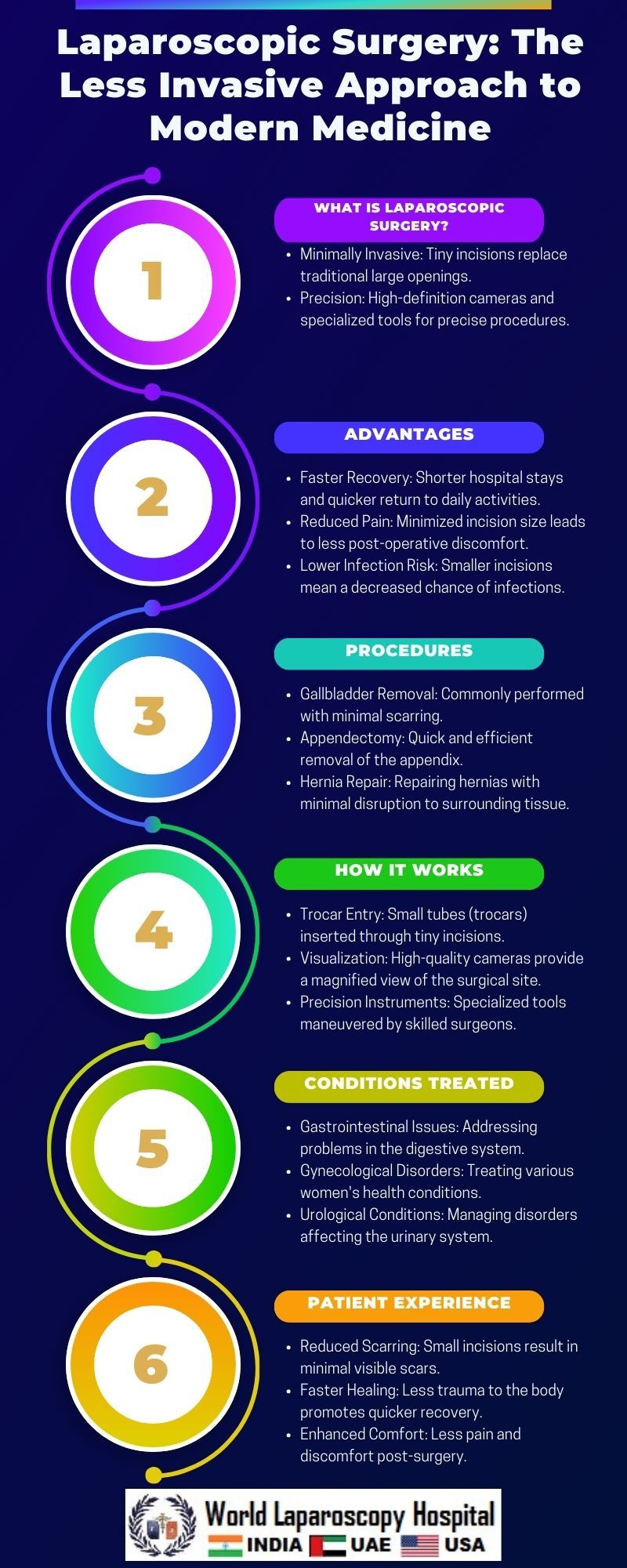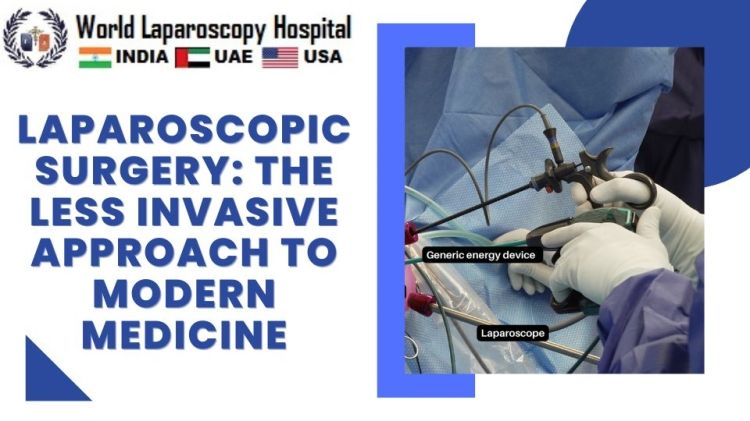Laparoscopic Surgery: The Less Invasive Approach to Modern Medicine
Introduction
In the ever-evolving landscape of medical science, one of the most groundbreaking advancements in surgical procedures has been the advent of laparoscopic surgery. This less invasive approach has transformed the way surgeries are performed, offering patients faster recovery times, reduced pain, and minimized scarring compared to traditional open surgeries. In this article, we will delve into the world of laparoscopic surgery, exploring its history, techniques, applications, advantages, and the potential it holds for the future of modern medicine.

The Evolution of Laparoscopic Surgery
The roots of laparoscopic surgery can be traced back to the early 20th century when a German surgeon named Georg Kelling first used a cystoscope to examine the abdominal cavity. However, it wasn't until the 1980s that laparoscopic surgery gained widespread recognition and acceptance. The introduction of fiber-optic technology and advancements in video imaging paved the way for the development of specialized instruments and equipment, making it possible to perform surgeries with smaller incisions.
The first laparoscopic cholecystectomy (gallbladder removal) was performed by Dr. Erich Mühe in 1985 in Germany. This milestone marked the beginning of a new era in surgery, challenging the conventional norms of large incisions and prolonged recovery periods.
Techniques and Instruments Used in Laparoscopic Surgery
Laparoscopic surgery, also known as minimally invasive surgery or keyhole surgery, involves making small incisions (usually 0.5 to 1.5 cm) through which specialized instruments and a laparoscope are inserted. The laparoscope is a thin tube equipped with a light source and a camera, allowing surgeons to visualize the internal organs on a high-definition monitor.
The surgeon manipulates the instruments, which are controlled externally, to perform the necessary procedures. These instruments can include graspers, scissors, electrocautery devices, and staplers, among others. The entire surgery is guided by the real-time images captured by the laparoscope, providing a detailed view of the surgical field.
Applications of Laparoscopic Surgery
Laparoscopic surgery has found applications across various medical specialties, revolutionizing the way numerous procedures are performed. Some common procedures include:
Cholecystectomy (Gallbladder Removal):
As mentioned earlier, laparoscopic cholecystectomy was one of the first successful applications of this technique. The minimally invasive approach significantly reduces postoperative pain and shortens recovery times compared to traditional open surgery.
Appendectomy:
Removal of the appendix is another common laparoscopic procedure. The small incisions result in less scarring and a faster return to normal activities.
Hernia Repair:
Laparoscopic techniques are often employed for repairing inguinal, ventral, and hiatal hernias. The smaller incisions reduce the risk of infection and hernia recurrence.
Gynecological Procedures:
Laparoscopic surgery has revolutionized gynecological procedures such as hysterectomy, myomectomy (fibroid removal), and ovarian cystectomy. These procedures offer reduced pain, quicker recovery, and improved cosmetic outcomes.
Colorectal Surgery:
Various colorectal surgeries, including colectomy and rectal resection, can be performed laparoscopically. This approach minimizes the trauma to the abdominal wall and results in shorter hospital stays.
Bariatric Surgery:
Laparoscopic techniques are commonly used in weight loss surgeries like gastric bypass and sleeve gastrectomy. The smaller incisions contribute to faster recovery for patients seeking bariatric interventions.
Advantages of Laparoscopic Surgery
The shift towards laparoscopic surgery is driven by the numerous advantages it offers over traditional open procedures. Some key benefits include:
Reduced Pain:
Smaller incisions result in less trauma to the tissues, leading to reduced postoperative pain. Patients often require less pain medication and experience a quicker return to normal activities.
Faster Recovery Times:
The minimally invasive nature of laparoscopic surgery allows for quicker recovery compared to open surgeries. Patients typically spend less time in the hospital and resume normal activities sooner.
Minimal Scarring:
The small incisions in laparoscopic surgery result in minimal scarring, enhancing the cosmetic outcomes of the procedures. This is particularly important for patients concerned about the aesthetic impact of surgery.
Lower Risk of Infections:
Smaller incisions reduce the risk of surgical site infections. The closed nature of the procedures minimizes exposure to external contaminants, contributing to better overall outcomes.
Shorter Hospital Stays:
Many laparoscopic procedures are performed on an outpatient basis, allowing patients to return home on the same day. Even for more complex surgeries, the hospital stay is often shorter compared to open procedures.
Improved Visualization:
The use of laparoscopes provides surgeons with high-definition, magnified views of the surgical site. This enhanced visualization allows for greater precision and accuracy during the procedure.
Challenges and Limitations
While laparoscopic surgery has transformed the field of medicine, it is essential to acknowledge its challenges and limitations. Some of these include:
Steep Learning Curve:
Laparoscopic surgery requires specialized training, and there is a learning curve associated with mastering the techniques and hand-eye coordination needed for precise movements.
Equipment Costs:
The initial setup costs for laparoscopic equipment can be significant. However, the long-term benefits in terms of reduced hospital stays and faster recovery may offset these expenses.
Not Suitable for Every Procedure:
While laparoscopic techniques have expanded into various specialties, not all procedures are suitable for this approach. Certain complex surgeries may still require open techniques.
Risk of Complications:
Although the risk of surgical site infections is lower, laparoscopic surgery is not without its complications. In rare cases, there may be issues such as bleeding, organ injury, or infection.
Limited Tactile Feedback:
One limitation of laparoscopic surgery is the lack of direct tactile feedback. Surgeons rely on visual cues and instruments, but they do not have the same sense of touch as in open surgery.
Future Directions in Laparoscopic Surgery
The continuous evolution of laparoscopic surgery opens up new possibilities and avenues for exploration in the field of medicine. Some areas of interest and potential advancements include:
Robot-Assisted Laparoscopic Surgery:
The integration of robotic systems into laparoscopic procedures is an exciting development. Robotic-assisted surgery offers enhanced precision and dexterity, allowing surgeons to perform intricate movements with greater control.
Augmented Reality (AR) and Virtual Reality (VR):
The incorporation of AR and VR technologies into laparoscopic surgery could provide surgeons with immersive, three-dimensional views of the surgical field. This could further enhance visualization and improve surgical outcomes.
Miniaturization of Instruments:
Ongoing efforts to miniaturize laparoscopic instruments aim to reduce the invasiveness of procedures even further. Smaller instruments could lead to tinier incisions and potentially faster recovery times.
Enhanced Training Programs:
As laparoscopic surgery becomes more widespread, the development of comprehensive training programs becomes crucial. Simulators and virtual training modules can help surgeons hone their skills in a controlled environment.
Expanding Applications:
Researchers are exploring new applications for laparoscopic surgery, including in fields such as neurosurgery and orthopedics. The potential to apply minimally invasive techniques to a broader range of procedures could revolutionize these specialties.
Conclusion
Laparoscopic surgery has undoubtedly transformed the landscape of modern medicine, offering patients a less invasive alternative to traditional open procedures. The continuous refinement of techniques, the integration of advanced technologies, and ongoing research promise an exciting future for laparoscopic surgery. As the field evolves, it will be essential to strike a balance between embracing innovation and ensuring the safety and well-being of patients. With its numerous advantages and the potential for further advancements, laparoscopic surgery stands as a testament to the remarkable progress in medical science, ushering in a new era of surgical care.






